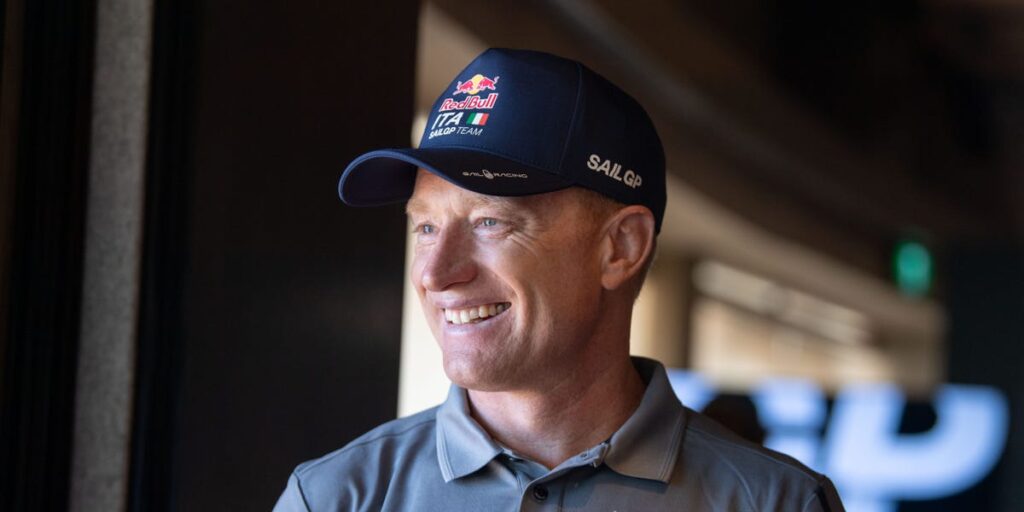This as-told-to essay is based on a conversation with Jimmy Spithill, the 45-year-old CEO of the Red Bull Italy SailGP Team, about his daily routine. It’s been edited for length and clarity.
I grew up just north of Sydney in Pittwater. To go anywhere, from school to buying groceries, we had to go by boat.
I started windsurfing at 5 and started taking the boat out by myself when I was a bit older. Two team members of the 1983 America’s Cup-winning yacht Australia II lived nearby, and they were heroes to me.
I entered the boating industry in 1991, and my first job was at Beashel’s Boatshed when I was still in primary school. Colin Beashel was the mainsheet trimmer, a crewmember on Australia II, and his dad, Ken, was its shore boss.
In 1998, I finished third in the Sydney to Hobart Yacht Race. At 20, I became skipper of Young Australia for the 2000 America’s Cup, before skippering the winner in 2010 and 2013.
I don’t race anymore myself. Now, I’m the CEO and one of the owners of the Italian SailGP team, where I look after everything on and off water, with a particular focus on leadership and commercial development. Here’s what a day in my life is like.
5-6 am: get up and go to the gym
Sail GP is a high-speed global sailing competition featuring identical, technologically advanced F50 catamarans. The races happen all over the world in cities like New York and Geneva, so I travel with the team. If it’s a race day, I like to get up early.
I still like to think I’m an athlete, and I always find I make better decisions if I get up and get the blood pumping. I hit the gym in the morning before I do anything else.
Then, I’ll typically start working through what needs to be done over a breakfast of coffee and a shake. That could mean checking whether we’ve got investors or sponsor guests coming in, or if we’re doing an activation with another Red Bull athlete. Red Bull is our title partner, and we do a lot of cross-promotion.
I’ll return emails, check the weather forecast, and have a pre-briefing with our athletes.
9 am: head down to base
We have a proper race-day briefing — a lot like a Formula 1 team — with our coaches, data analysts, and athletes all sitting together, going through the screens and telemetry. Usually, we’re looking at data from the practice races to work out what went well, what didn’t, and what the other teams are doing.
One of the unique things about SailGP is that all the data is open and completely shared between the teams. The challenge is that there’s so much of it — the trick is figuring out what’s actually useful and what’s just noise.
12 pm: race time
We usually have races on Saturday and Sunday, and during those, I’m down in the pit lane booth, again very similar to Formula 1. All the coaches and analysts from all the teams are set up there.
I’m usually in and out, splitting my time between being with the team and spending time with guests and investors at the race.
Anyone who comes to a SailGP event is blown away. You’ve got 12 high-performance boats racing at 100 kilometers an hour in very tight stadium racing. The races are around 13 minutes long. It’s thrilling.
2 pm: debrief
After the race, we’ll come back and do a proper debrief. This includes reviewing performance and data and thinking about how to improve further in the next race.
That’s often followed by dinner with a sponsor or partner. I try to eat as organically as possible, and avoid dairy, gluten, and processed foods. I’m not perfect, and it can be challenging when travelling.
We’ve just gone to market, so we’re doing a lot of work on our commercial side, such as engaging new sponsors and working with investors and broadcasters.
10 pm: sleep
I’ll try to review the race footage again before I go to bed. Then it’s rinse and repeat for Sunday.
I’ve been forcing myself to try not to look at my phone 30 minutes before bed and read, but that’s still a work in progress.
Away from race days, my schedule is more relaxed
I’m based in Monaco for work, but my wife and children are in San Diego. I’m travelling back and forth a lot, but we’re all used to it. I spend about one week a month at home.
The majority of the off-water work is about building toward the next event and ensuring the team’s sustainability and success.
In between events, I’m also doing a lot of video calls with the athletes
These are often on Zoom, going through performance data. We’ll try to pick out the lessons from the last race that can help us improve.
We’ve got a really young, talented group of athletes, and like any top-level sport, there are no shortcuts. You have to get the hours in. You have to do the work.
We’re the newest team in SailGP, but we’re ambitious. Only a handful of teams in the league are profitable, which is pretty rare in professional sports. Our goal is to be commercially sustainable.
Read the full article here


